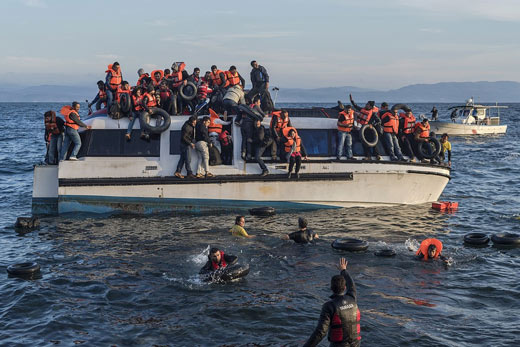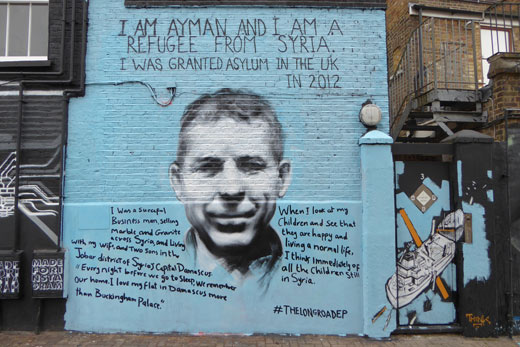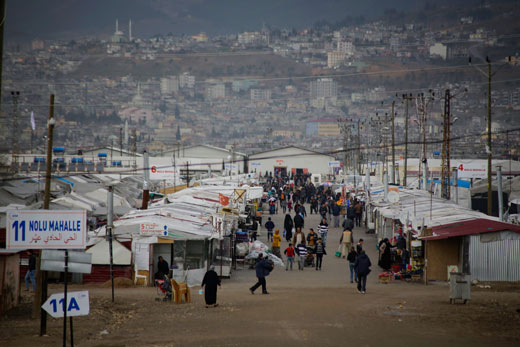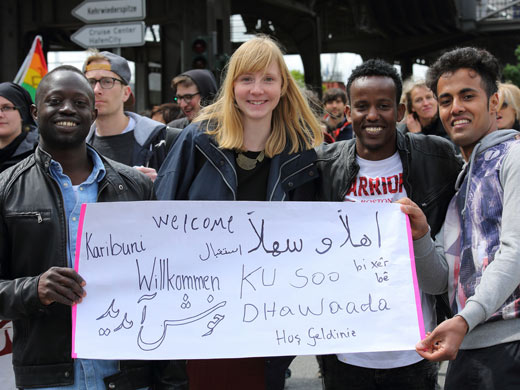ARTICLE
Between sticks and carrots: The future of EU migration deals
The EU aims to establish ‘deals’ with third countries: political packages which encompass clear targets and joint commitments. A ‘win-win-win’ situation is envisaged by combining different policy elements beyond migration, such as trade and development. This article aims to contribute to the debate about ‘new’ migration partnerships by looking back – what can we learn from EU-migration agreements since the 1990s – and forward – what are the challenges?[1]
Since the beginning of 2015, the European migrant crisis, or the European refugee crisis, is at the top of policy agendas of the EU as well as of individual European countries. In this period, rising numbers of asylum seekers and migrants travelled across the Mediterranean Sea or over land through Southeast Europe to arrive in the European Union for building a safer and better life. The top three nationalities of entrants of the over one million Mediterranean Sea arrivals between January 2015 and March 2016 were Syrian (47%), Afghan (21%) and Iraqi (9%), in addition to considerable numbers coming from various African countries.[2] In addition to problems that are related to how to deal with the inflow of thousands of migrants (mostly concentrating in Italy and Greece), the number of deaths at sea rose to record levels in April 2015, when more than 1200 people drowned in the Mediterranean sea after the sinking of their boats.[3]
One of the direct responses in order to tackle the refugee ‘crisis’ was the EU-Turkey deal which formally came into effect on 20 March 2016. According to the EU-Turkey deal Turkey agreed to collaborate in a scheme which enforces that migrants arriving in Greece who did not apply for asylum or whose claim was considered illegible would be sent back to Turkey. With the deal, it was hoped people would be discouraged from making the dangerous journey by sea from Turkey to Greece. In return, Turkey would receive aid and political concessions like visa deregulation.

© WikimediaCommons
Syrian and Iraqi refugees arrive from Turkey to Lesbos Greece in 2015
This deal fits a wider trend in Europe of externalising migration policies and shifting responsibilities for migration control onto countries of origin and transit. Looking at the outcomes of the EU-Turkey deal, however, it is clear that such an approach will not come uncontested. Since the start of the deal, there has been much discussion about its ‘success’. The inflow of migrants and refugees has considerably decreased, but it is not clear whether this ‘success’ can be attributed to the EU-Turkey deal: according to the opponents of the deal, reduced inflows of migrants and refugees into the EU was the consequence of the closure of the Balkan route, as well as the result of normal seasonality and the ending of the migration life cycle, with most people having left in earlier periods. In addition, opponents criticise the EU-Turkey deal for being illegal and immoral: along with the introduction of the deal, possibilities for people to receive asylum are very much reduced and increasing numbers of people are forced to return. In spite of human rights violations, Turkey is presented as a safe country and there is much discussion about the EU being responsible for people being detained in Turkey without access to asylum.[4]
There are also problems of implementation: Greece and Turkey do not have the required capacity to host and ‘process’ large numbers of people, who in majority will be forced to return to their countries of origin. Also, the accompanying system to redistribute accepted refugees throughout the EU has largely failed, as member states have not kept their promises. At the start of the EU-Turkey deal it was promised to resettle 72.000 refugees across EU member states. However, in November 2017, less than 9.000 have been resettled under the EU-Turkey deal. At the borders of Europe – within and outside of the EU – large and heterogeneous groups of refugees/migrants are kept in overcrowded camps, often without legal support or even in detention.
The externalisation of the EU border – finding ways to keep irregular migrants out while simultaneously taking care of creating ‘legal ways’ is presented as the ‘new’ EU approach
In spite of these problems, the externalisation of the EU border – finding ways to keep irregular migrants out while simultaneously taking care of creating ‘legal ways’ is presented as the ‘new’ EU approach. This approach was confirmed again during the emergency summit on the migration crisis late June. After the 2015 Valetta Summit, the 2015 EU-Turkey joint action plan and the 2016 EU-Turkey deal, the European Commission proposed a new migration partnership framework which was endorsed by the European Council in June 2016. In the context of this framework, the EU will seek to make tailor made partnerships with key third countries of origin and transit. More concretely, by establishing ‘migration compacts’ with countries such as Jordan, Lebanon, Niger, Nigeria, Senegal, Mali, Ethiopia, Tunisia, Libya, Morocco, Algeria, Iran, Egypt, Afghanistan, Pakistan, and Bangladesh, the EU aims to solve the ‘European migration crisis’. The partnerships are expected to contribute to saving lives, fighting trafficking, breaking smuggling networks, increasing returns while enabling migrants and refugees to stay closer to home and helping countries to addressing the root causes of migration.[5]
The EU thus aims to establish ‘deals’ with third countries: political packages which encompass clear targets and joint commitments, including but not limited to the conclusion of formal agreements on readmission.[6] A ‘win-win-win’ situation is envisaged by combining different policy elements beyond migration, such as trade and development. These new EU policies are very much in line with the ‘UN global compact on migration’ (New York 2016) trying to arrive at a new and more integrated approach aiming at coordinated and structural cooperation with third countries. Such a framework should contribute to safe, regular and orderly migration, which is also in line with the Sustainable Development Goals. This article aims to contribute to the debate about ‘new’ migration partnerships by looking back – what can we learn from EU-migration agreements since the 1990s – and forward – what are the challenges?

© Duncan c / Flickr
Street art in London
Learning from experiences with EU Migration Agreements since the 1990s
The EU-Turkey deal and the new migration partnership framework are in many respects not new. Since the 1990s, numerous bilateral migration agreements have been instituted between EU member states and countries of emigration and transit with multiple goals. The past two decades have seen the steady emergence of various bilateral and multilateral migration agreements between Europe and migrant sending countries in the global South, focusing on controlling migration (concentrating on fighting irregular migration, re-admission and repatriation), often in combination with encouraging legal migration (by using migration quota, circular migration) and/or stimulating co-development. In the course of time, migration agreements have increasingly become focused on migration restriction and control, and the externalisation of the EU’s migration control has intensified. Especially since 2004 (along with the creation of Frontex - the European agency for the management of operational cooperation at the external borders of the member States of the European Union) agreements on ‘preventing and combating irregular labour migration (including admission procedures and arrangements for repatriation, social security, family reunification, integration and return) have become dominant. Over time, a large number of migration-related agreements have been signed between the EU – or EU countries such as France, Italy, Spain, the UK and many others on the one hand, and emigration and transit countries on the other , varying from Ghana and Senegal, Cape Verde and Nigeria; Bolivia and Ecuador; but also the Philippines, Russia and Hong Kong[7].
Learning from experiences with bilateral and multilateral agreements from the past decades, it is clear that the EU and its member states (in the beginning in particular France, Italy and Spain) have provided African and Mediterranean countries with substantial financial and personnel support in controlling borders, fighting human trafficking and strengthening their police and intelligence apparatus. Making an assessment of experiences with such EU-driven bilateral and multilateral agreements with countries of emigration and transit, we see that these practices have given rise to four criticisms:
ineffectiveness in controlling migration e.g. due to spatial substitution effects like changes of migration routes
unequal power relations leading to unbalanced and ineffective partnerships
high informality and lack of transparency in negotiations
violation of migrants’ human rights
Changing migration routes
First, with regard to the spatial substitution effects and changing migration routes, it is important to rethink the effectiveness of restrictive and securitized migration policies. The introduction of tougher rules regarding regular migrants’ entry to and residence in Europe has, since the mid-1990s, inadvertently pushed irregular West African migrants to use complex routes to reach the Maghreb as a transit region, in order to enter Europe clandestinely.[8] It is without doubt that FRONTEX operations (and outsourcing the responsibility of stopping migrants to the Maghreb) has resulted in a southward shift of migration networks, and an intensification of migration industries.[9]
Unequal power relations
Second, EU migration agreements until now were very top-down and unequal. Apart from the question of externalisation of migration control, negotiations on bilateral and multilateral agreements often took place on initiative of the EC and with significant power play and unilateralism from the European side, as Europe pushed for agreements with third countries in a non-participatory way (e.g. in the case of the EU Mobility Partnerships of 2008). The cost-benefit balance for these countries was often lost.[10] Problems with the readmission of third country nationals were, and still are, often a sensitive issue in migration agreements, but the EU’s push for these issues has only increased (e.g. in case of the EU-Turkey deal). As a result of these imbalanced cost-benefit distributions, the implementation of these agreements proved less effective due to non-cooperation by third country governments in practice.
Lack of transparency
Third, EU-related migration agreements have been criticized for a lack of transparency and the high level of ‘informality’. Negotiations between EU member states and African countries often took place behind closed doors and often ad hoc in response to rapidly changing situations. Arrangements for repatriation and migration control, as well as incentives such as development aid and preferential entry quota, were often established outside formal agreements. This meant not only that these arrangements were less transparent and controllable by parliaments, but that there were limited checks and balances. Politically sensitive issues, such as financial clauses and collaborating institutions, were often arranged outside formal agreements. Agreements often remained unpublished, allowing governments to collaborate with all kinds of institutions, such as local intelligence services and private security companies, without parliamentary control.
Violation of migrants’ human rights
Finally, migration agreements were problematic in terms of human rights. European police and immigration services were sometimes blamed for collaborating with organisations that were mentioned as being responsible for torture, disappearances and political liquidations – and sacrificing human rights for the sake of stopping migration (examples of human rights violations taking place in the Maghreb region are numerous). As the consequence of stricter rules, irregular migrants ‘in transit’ often found themselves in highly vulnerable situations. In addition, there were frequent violations of the ‘non-refoulement’ principle: a fairly large number of transit migrants caught in the Mediterranean came from countries where their lives were in danger, but they did not get asylum.[11] Hence as a consequence of such externalisation policy, transit migrants and refugees have often become more vulnerable. Repatriation of refugees and migrants has regularly led to their imprisonment and torture.

© European Union
Refugee camp Kahramanmaras in Turkey, 2016
Moving forward: from migration deals to investment plans
Until now, migration agreements often aimed at controlling or stopping migration have not been able to solve the migration crisis. Worse, stricter rules will push migrants into new directions and unknown routes, making migration an ever-increasing risky and costly enterprise. This is often a temporary outcome to the extent that numbers have decreased. People will postpone or search for new entry points: Europe is a waterbed. ‘Keeping’ people in camps is not in line with European values, but proves also to be unproductive. It leads to capital destruction, financially as well as socially.
The ambition to shift from restrictive measures to a more facilitating approach (offering opportunities for legal migration and funding for sustainable development) is positive, but until now benefits have been limited: plans for new agreements might contain more ‘carrots’ than before, but restricting and controlling migration, the stick, is still the dominant goal and how the many dilemma’s mentioned above are dealt with is unclear.
Instead of stopping migration, priority should be given to steering migration flows in the ‘right direction’
Up until now, migration deals have not been able to turn the tide, in spite of enormous spending, which often go at the cost of the aid budget for the poorest countries. Under the current approach, gigantic sums are spent on border controls and Frontex ships, reception camps and detention centres, asylum procedures, deportations and reception centres – not to mention rescuing people from the sea, despite the fact that the migrants continue ‘to stream in’. This approach will in the longer run be socially and financially unsustainable. The manner in which migrants and refugees are dealt with is at odds with global sustainability objectives (‘leaving no one behind’) and criteria for ‘good governance’. People are shut up at the gates of Europe for years with no prospect of a decent existence. The procedure is not transparent: a large corps of officials, assisted by translators, is engaged in screening people on the basis of hard criteria, but much of the work is done behind closed doors. The rights of migrants are determined by where they come from and little is asked about their qualifications, about their preferences, or where they could best thrive. Migrants and deportees are treated as playthings and when they finally arrive at the place of destination after years, it is usually not the place of their first choice.

© Rasande Tyskar / Flickr
In Hamburg people took to the streets in 2016 in order to express their protest over inhumane deportations of refugees.
It is time for a fresh approach. Instead of stopping migration, priority should be given to steering migration flows in the ‘right direction’. Instead of the top-down ‘distribution’ of migrants and refugees over Europe, the challenge is to channel migrants to those places where they best ‘fit’ and optimise the chances for successful integration. Screen migrants and refugees, not only for origin and status, but also take their motivation and qualities into account as well as their social networks. Stop spending so much on border control and shutting migrants up in camps for years. Use the money for providing legal ways for migration by investing in extra jobs and infrastructure, and make sure that local communities, both hosts and newcomers, benefit from the new investments.
Instead of using European funds for the closure of borders or readmission procedures, trillions of euro’s can be made available for employment and infrastructure development, for example in those regions in Africa that have to contend with forced migration and/or regions that fulfil a function in the reception of refugees from neighboring countries. Instead of making big deals with national governments, it is important to sufficiently involve local groups and at least give them a say in the type of investments needed.
Part of the available funding can also be directed to particular areas within Europe that suffer from population loss and ageing and are prepared to take in refugees and migrants. In countries such as Spain, Portugal, France and Greece many provinces and municipalities have to contend with depopulation and ageing. Migrants can help to turn the tide, but investments are required. Especially if the ‘hosting’ of migrants is accompanied by the receipt of a bonus in the form of investments in jobs, training facilities, a better infrastructure or a wider range of facilities, the willingness to host migrants and/or refugees will increase, and there will be better opportunities for integration. If the local population has a say in this and the arrival of migrants also offers clear advantages for them, the prospects for integration will be much greater than in the present system where there is often a wide ‘gap’ between decision makers and the civilian population.
Instead of punishing local authorities ‘top-down’ when they fail to adhere to quotas imposed from above, a ‘bottom-up’ policy, in which citizens and local authorities are rewarded for initiatives in which the expansion of employment and integration are combined, will probably be many times more successful[12]. All this will help EU migration policies to become more effective and humane, and also better in line with the Sustainable Development Goal of ‘leaving no one behind’.



